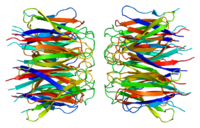
Photo from wikipedia
NPM1 -mutated acute myeloid leukemia (AML) represents the most frequent genetic subtype of AML, accounting for about 30% to 35% of newly diagnosed cases in adults. 1 Because of its… Click to show full abstract
NPM1 -mutated acute myeloid leukemia (AML) represents the most frequent genetic subtype of AML, accounting for about 30% to 35% of newly diagnosed cases in adults. 1 Because of its distinctive clinico-pathological and molecular features, 2 – 4 NPM1 -mutated AML is recog-nized as a distinct entity in the World Health Organization (WHO) classification of myeloid neoplasms. 5,6 The NPM1 gene encodes for a multifunctional protein with chaperone activity, 7 which continuously shuttles between the nucleus and the cytoplasm, but mainly resides in the nucleoli. 8 The most distinguishing feature of NPM1 -mutated AML is the aberrant localization of mutant NPM1 (NPM1c) from the nucleo-lus to the cytoplasm of leukemic cells. 9 – 11 The abnormal NPM1c localization is secondary to the loss of nucleolar localization signal (tryptophans at positions 288 and 290 or 290 only) and the acquisi-tion of a strong nuclear export signal at the C-terminus, which promotes
Journal Title: American Journal of Hematology
Year Published: 2023
Link to full text (if available)
Share on Social Media: Sign Up to like & get
recommendations!